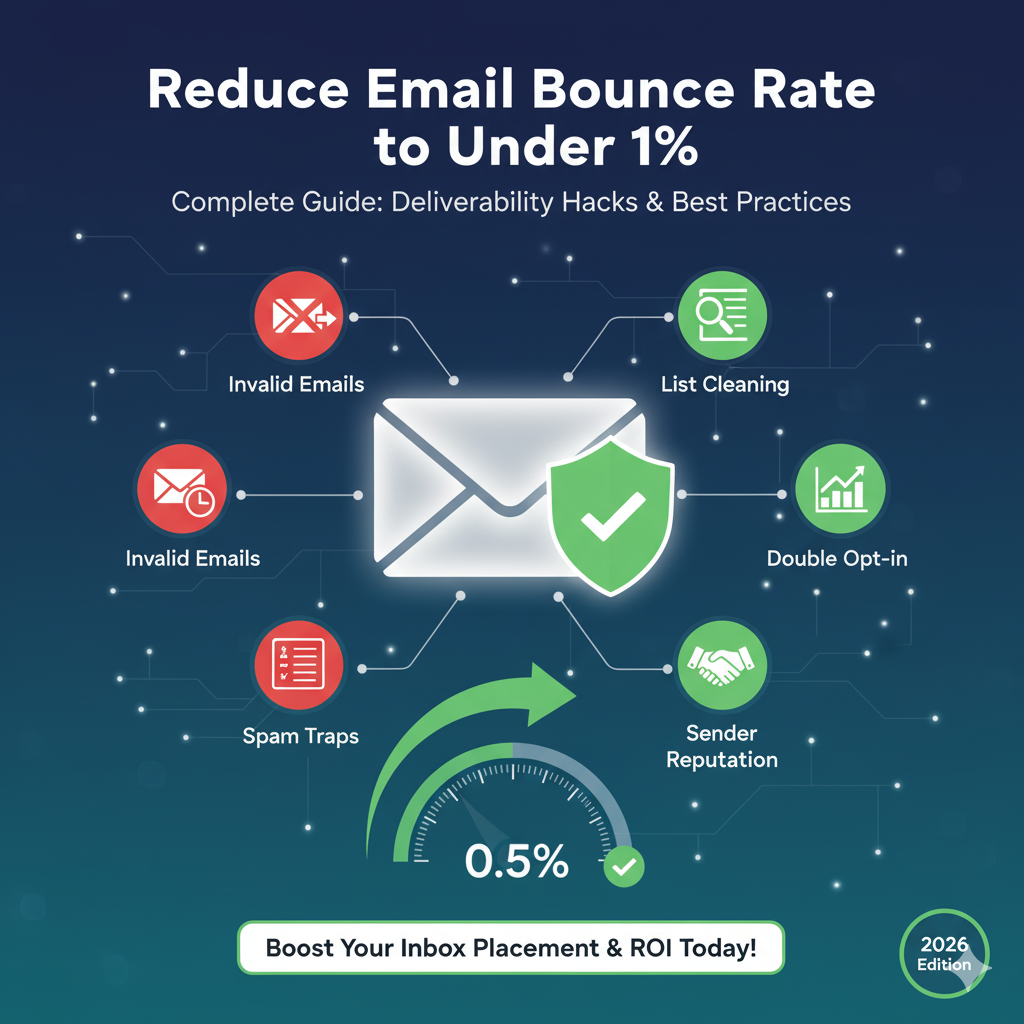To reduce your email bounce rate to under 1%, you’ll need to differentiate between soft and hard bounces, manage your list effectively, and verify email addresses. Regularly clean your list by removing inactive subscribers and employing double opt-in methods. Use verification techniques to ensure addresses are valid and actively receiving emails. By monitoring your bounce rates consistently, you can identify and address issues promptly. Follow along to discover more strategies that can enhance your email deliverability.
Table of Contents
Key Takeaways
- Regularly clean your email list by removing inactive subscribers and hard bounces to maintain list health and credibility.
- Implement double opt-in methods to confirm subscriber intent and verify valid email addresses before adding them to your list.
- Utilize syntax and domain verification techniques to ensure email addresses are correctly formatted and domains are active.
- Monitor bounce rates consistently, analyzing trends and segmenting lists to identify and address specific issues promptly.
- Follow best practices in list management, including segmentation and engagement strategies, to enhance overall email deliverability and effectiveness.
Understanding Email Bounce Rates
How well do you understand email bounce rates? Grasping this concept is crucial for any marketer.
Email bounce rates represent the percentage of your sent emails that don’t reach the recipient’s inbox, and they can significantly impact your campaigns.
To improve your outcomes, you’ll need some educational insights into what causes these bounces and how they affect your sender reputation.
A statistical overview reveals that a bounce rate above 2% can harm your domain’s credibility.
Regularly monitoring your metrics allows you to identify issues promptly.
By understanding the factors contributing to bounces, you can take proactive steps to enhance deliverability and ensure your messages reach your audience effectively.
This knowledge is key to reducing your email bounce rate.
Types of Bounces: Soft vs. Hard
When dealing with email bounces, it’s important to know the difference between soft and hard bounces.
Soft bounces occur due to temporary issues, like a full inbox or server problems. These emails might get delivered later, so you shouldn’t remove these addresses immediately.
Hard bounces, on the other hand, indicate permanent failures, such as non-existent email addresses or blocked domains.
Ignoring hard examples can hurt your sender reputation and lead to future delivery issues.
To maintain a healthy email list, regularly monitor bounces and take action.
By distinguishing between these two types, you can improve your overall email deliverability and reduce your bounce rate effectively.
Understanding this distinction is crucial for successful email marketing.
Best Practices for List Management
Effective list management is essential for reducing email bounce rates and enhancing your overall email marketing strategy.
To achieve successful audience growth and maintain a healthy email list, consider these best practices:
- Regularly Clean Your List: Remove inactive subscribers and bounced emails to keep your list fresh and engaged.
- Implement Segmentation Strategies: Group your audience based on interests or behavior. This ensures your content is relevant, reducing the likelihood of bounces.
- Use Double Opt-In: Confirm subscribers’ interest with a double opt-in method. This verifies their intent and helps maintain a quality list.
Effective Email Verification Techniques
What strategies can you employ to ensure the accuracy of your email list?
Start with syntax checking, which verifies that email addresses follow the correct format.
This step helps catch typos and prevents sending to invalid addresses.
Next, implement domain verification to confirm that the domains in your list are active and capable of receiving emails.
You can use tools that automatically check the validity of each domain, saving you time and reducing bounce rates.
Additionally, consider using double opt-in methods, where subscribers confirm their email addresses before you add them to your list.
Monitoring and Analyzing Bounce Rates
After implementing effective email verification techniques, you’ll want to monitor and analyze your bounce rates to ensure ongoing list health.
Here’s how to do it effectively:
- Trend Analysis: Regularly review your bounce rate data to identify patterns. Are certain email campaigns consistently bouncing? This insight helps you adjust your approach.
- Live Tracking: Utilize tools that offer real-time bounce notifications. This immediate feedback lets you react quickly and maintain a clean list.
- Segment Your List: Break down your audience into different segments. Analyzing bounce rates per segment can highlight specific issues, allowing for targeted improvements.
Frequently Asked Questions
How Often Should I Clean My Email List?
You should clean your email list every six months to maintain its health. Following these frequency guidelines ensures better engagement rates. Consider shorter cleaning intervals if you notice increased bounce rates or inactive subscribers.
What Tools Can Help Reduce Bounce Rates?
To reduce bounce rates, use tools like predictive analytics for better targeting and API integration to streamline data management. These resources help you maintain a clean email list and enhance your overall email deliverability.
Can Bounce Rates Affect My Sender Reputation?
Absolutely, bounce rates can tank your sender reputation. Ironically, while you aim for high engagement, poor reputation metrics from high bounce rates push you further from success, damaging your sender scoring. Keep your list clean!
Is It Okay to Purchase Email Lists?
It’s not okay to purchase email lists. Doing so raises ethical dilemmas and legal risks, potentially harming your reputation. Instead, focus on building organic lists to ensure better engagement and compliance with regulations.
How Do I Reactivate Inactive Subscribers?
To reactivate inactive subscribers, use reengagement tactics like sending personalized incentives. Craft appealing offers tailored to their interests, and encourage them to engage with your content again. A little motivation can spark their interest!
Conclusion
By implementing these strategies, you can effectively reduce your email bounce rate to under 1%. Remember, a staggering 21% of emails are never delivered due to poor list management and verification practices. Imagine the potential customers you’re missing out on! When you take the time to clean your list and verify emails, you not only improve your deliverability but also build stronger connections with your audience. Don’t let bounces hold you back—start optimizing today!







